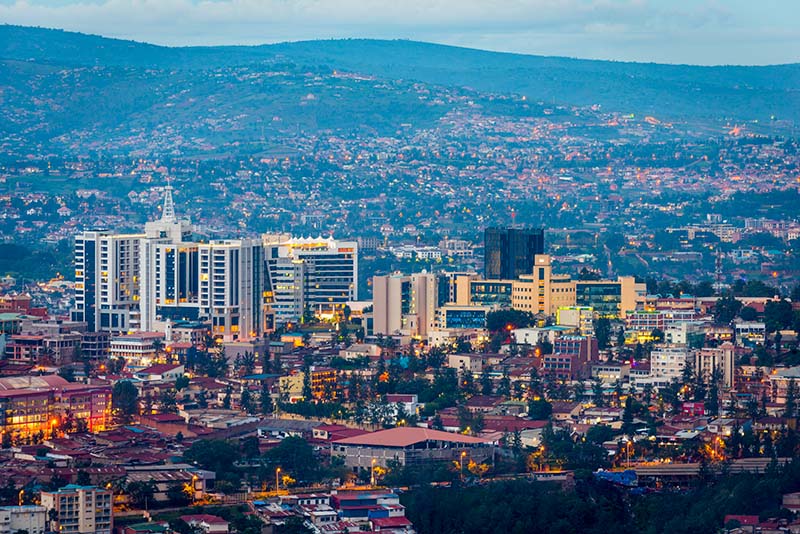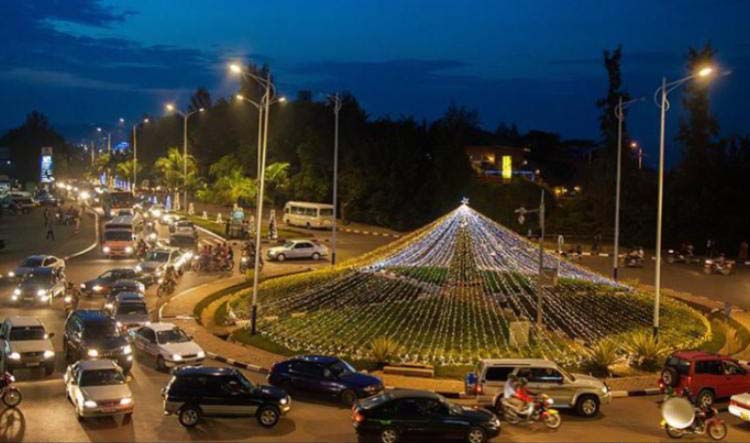Rwanda is deploying an innovative strategy to electrify its transportation system by providing public transportation via car sharing in a digitally enabled approach called “integrated mobility.” One researcher modeled renewably powered EV charging stations for the capital city of Kigali using UL’s HOMER Grid.
Rwanda has embarked on bold commitments to reduce climate change with a pledge to reduce its greenhouse gas emissions by 38% by 2030, according to the country’s climate resilience plan.

Although Rwanda has among the lowest per capita carbon emissions in the world, like many African countries, the country has already experienced devastating climate impacts, including flooding and landslides. To combat further global warming, the Rwandan government has identified reforms in the transportation sector as a prerequisite for achieving ambitious climate goals. The country plans to introduce electric vehicles (EV) and widespread electrification of the country’s transportation system as one carbon reduction strategy.
But adding EVs is only part of the equation. The cars also need to be powered up, which will require new charging stations — a vital part of the investment necessary to make the program a success, explained researcher Kwitonda Japhet during the ninth annual HOMER Microgrid and Hybrid Power International Conference. In the session titled “C&I Behind-the-meter Projects and EV Charging: Moving Toward a More Resilient, Mobile Electrified Future,” Japhet described using HOMER Grid to model renewably-powered charging stations for the capital city of Kigali.
Kigali attracts early investments in electric vehicles
Rwanda has the highest population density in Africa and is growing rapidly, according to the UN’s Urban Electric Mobility Initiative. Growth projections for Kigali — Rwanda’s most important commercial center and largest city with slightly over one million inhabitants — show the city’s population expanding to 4.5 million inhabitants by 2050, adding to vehicle density and air pollution and stressing the city’s infrastructure. Kigali’s transportation sector contributes over 50% of the city’s carbon dioxide (CO2) emissions from vehicles that are primarily diesel-powered, adding to unhealthy air pollution and creating climate risk.
On the positive side, Rwanda’s economic outlook is improving as the country emerges as one of Africa’s fastest-growing economies: digitization and economic development have positioned the country well to make innovative plans for smart mobility.
The country’s rapid growth spurred Rwanda to embark on an ambitious plan to reduce climate risk through investments in public transportation, new transportation infrastructure and clean electric vehicles. Notably, rather than focusing on private cars, Rwanda set its sights on new business models for public transportation.
Given the data, the plan is well-founded: Africa has the lowest per capita vehicle ownership globally, so Rwandans are more likely to benefit from car-sharing and other transportation schemes — at least in the short term — than from purchasing a car.
Partnering with Volkswagen and Siemens
As part of a public-private partnership led by the German Federal Ministry for Economic Cooperation and Development, Volkswagen, Siemens and several other German companies launched an ambitious pilot project in 2019 to produce and deploy electric vehicles in Kigali. Initiating the “Moving Rwanda” pilot project, Volkswagen built a factory to produce electric vehicles, providing local jobs and training while Siemens develops EV charging stations.
Volkswagen launched its concept of “integrated mobility” for Rwanda after analyzing two market-driving factors. First, the company recognized that its new cars were too expensive for most African consumers. And second, the car company is betting that African consumers might leapfrog technology and embrace electric vehicles — just as they skipped landlines and adopted cell phones rapidly.
Armed with this assessment, Volkswagen developed the digital infrastructure for the residents of Kigali to share passenger vehicles using an app to book and pay for mobility services via cashless transactions. The services, including community car sharing, ride-hailing and car-sharing, give customers the flexibility to be driven or drive themselves and were initially provided to government organizations, corporations and NGOs.
While motorcycles have long been the most common vehicles on the streets of Kigali, some EVs are already providing a clean, safe alternative. The company is targeting the production of 600,000 electric cars per year by 2022.
HOMER study models EV charging stations in Kigali

While Kigali’s first EV charging stations remain connected to the grid, Japhet said the city suffers an imbalance in energy supply and demand that the introduction of large numbers of electric vehicles will exacerbate. He hypothesized that introducing renewably powered EV charging stations would help manage the energy on the grid while also mitigating C02 emissions. Japhet pointed out that renewable energy will also help cushion energy price increases for local consumers, illustrated by a recent rise in Kigali’s public transportation cost that coincides with fluctuations in oil prices.
Using the HOMER Grid software to model EV charging stations in Kigali, Japhet found several factors that make Rwanda a prime candidate for solar energy — proximity to the equator, relatively good insolation and cooler temperatures resulting from its high altitude. He also determined that EV charging stations using solar and batteries would produce a lower levelized cost of energy than grid-power and help stabilize the grid as electric vehicles gain greater penetration in Rwanda.
Readers can watch the proceedings of HOMER Energy by UL’s ninth annual HOMER Microgrid and Hybrid Power International on-demand. Kwitonda Japhet presented an EV charging feasibility study during the session dedicated to “C&I Behind-the-meter Projects and EV Charging: Moving Toward a More Resilient, Mobile Electrified Future.” This year’s conference theme, “Powering the New Energy World,” included six separate online sessions over three days. On-demand viewing is available on the conference website.

I believe EV technology and charging stations are the future for African economies, especially, the Southern African Development Commission, (SADC) with most countries in this Region getting an average sun irradience higher than the rest of Africa.
SADC has a population of approximately 200 million combined with good regional roads to perimeter borders of the economic space. The countries are fast moving towards economic integration.
Hi Herman,
Thank you so much for these insights. We hope to keep bringing you interesting news of microgrid development in Africa.
All the best,
Lili Francklyn